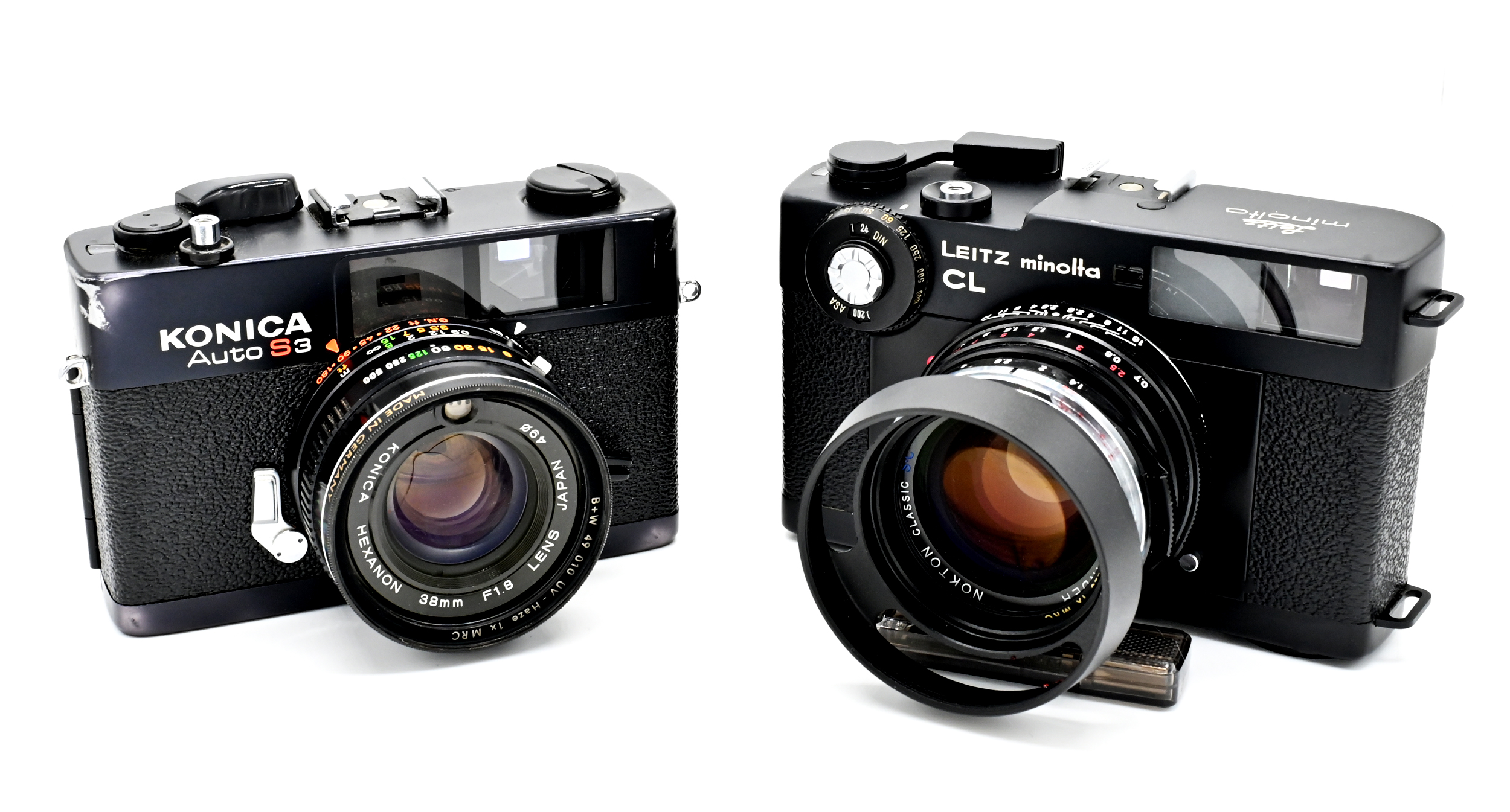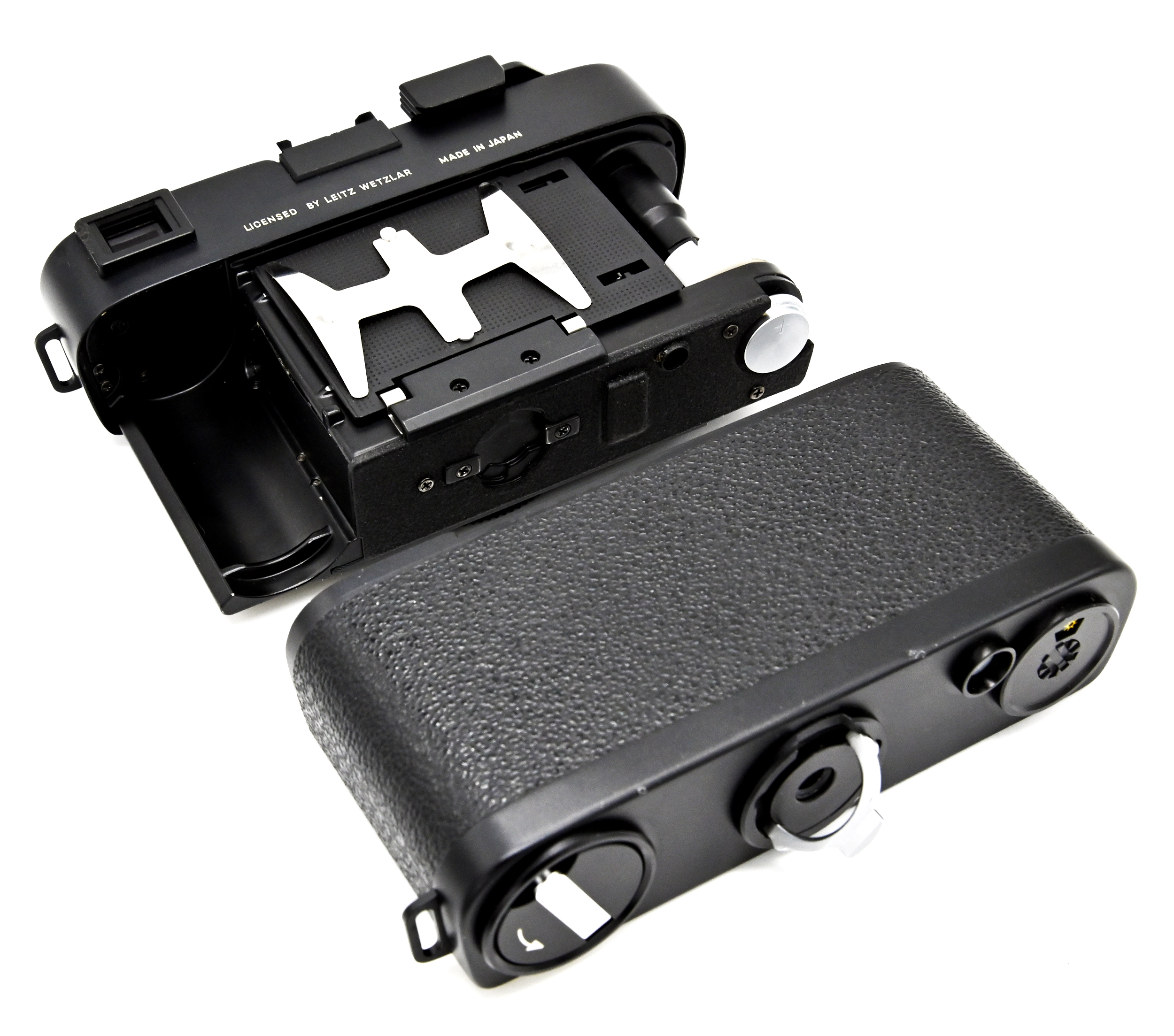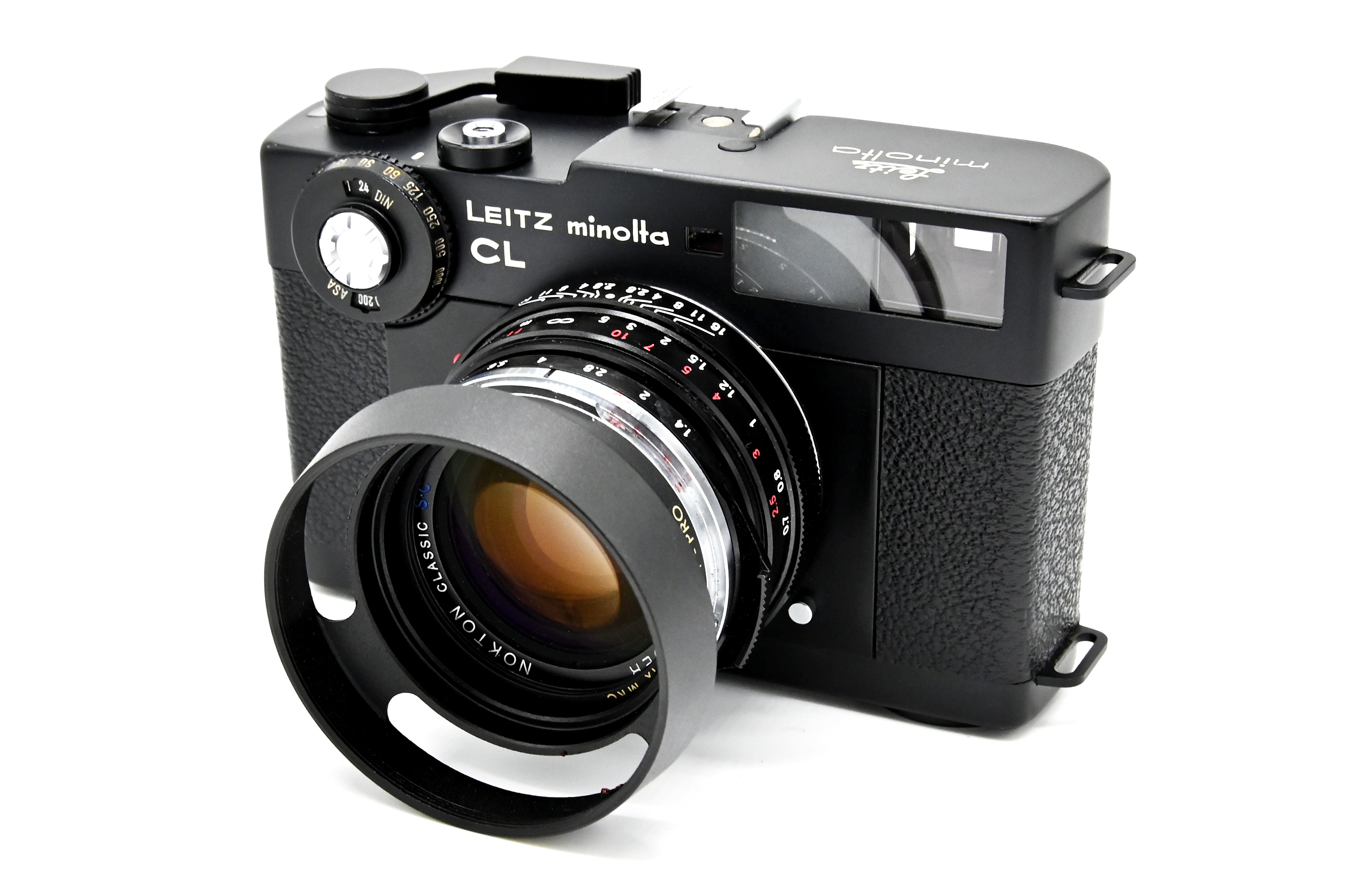
Produced from 1973 to 1976, the Leitz Minolta CL was the Japanese domestic market version of the Leica CL 35mm M-Mount camera, identical in all respects except for the nameplates. The CL was produced as a part of a collaboration between Leica in West Germany and Minolta of Japan that also spawned a few M-mount lenses and other products such as some of the earlier Leica R models. A very pricey camera in 1973, the CL (and the later 1980 Minolta CLE) remain the most compact Leica M-mount film bodies produced. Is the CL a viable alternative to a “real” M camera? Or should it just be appreciated for what it is? Let’s take a look.
As the story goes, by the late 1960s, Leica was in trouble. TTL light-metered SLRs were quickly becoming the standard for professionals. In 1971, Leica made a hard departure from the 1966 M4 in the form of the M5, a camera, while interesting and capable, never caught on. Leica’s answer to the Nikon F, the “Leicaflex” system, although advanced and still well-regarded today, never really caught on with the masses. By the early 1970s, West German camera companies generally were falling seriously behind technologically. During 1972, Leica struck up a partnership with Minolta, a collaboration that would lead initially to the Leica CL (manufactured in Japan) and the 1976 Leica R3 (manufactured in Germany). Similarly, Zeiss partnered with Yashica to produce a new generation of high-quality 35mm SLRs and lenses under the “Contax” brand name.
The early 1970s also witnessed an explosion of the automatic compact fixed-lens rangefinder camera. Although the idea of an easy-to-use, lightweight, metered, fixed-lens rangefinder had come of age in the 1960s, this next generation included cameras that were even smaller, lighter, and easier to use. Examples of these included the Canon QL17 G-III, the Yashica 35 Electro, the Konica Auto S3, and the Olympus 35RD. These cameras were extremely popular and relatively affordable.

The Leica CL was likewise a small, lightweight camera with a built-in meter with the capability of using most of the world of interchangeable M-mount and M39 lenses. At launch, two brand-new Leica M-mount lenses were offered with CL system: (1) the 40mm f/2 Summicon-C (in Japan, these lenses were rebadged as the “M-Rokkor 40mm f/2”); (2) and the 90mm f/4 Elmar-C. The 40mm Summicron is a fantastic little lens.
Neither the M5 nor the CL ended up being commercial successes. Leica shut down production of the M5 in 1975 and the CL in 1976. The CL may have been a camera in search of a market and was also a terribly expensive camera at the time: listed for around $600 with the 40mm f/2 Summicron in 1973 money (around $4,000 today) but sometimes advertised as low as $400-450 ($2,700-3,000). If shopping for a high-quality compact rangefinder camera in 1973, there were plenty of cheaper options.
The CL remains a forever orphan in the Leica universe. If you are looking for a low-cost entry point into Leica rangefinder photography, is the CL a good choice? If not, is it a good “side” Leica?” I am not sure if either is the case.
Operation
Viewfinder: The CL’s bright, parallax-corrected viewfinder can display framelines for 40mm, 50mm, and 90mm lenses. The 40mm and 50mm framelines are displayed by default, and the 90mm is displayed only when that lens is mounted. In my opinion, the CL’s display of the 40 and 50 framelines at the same time clutters the viewfinder. In my opinion, it would have been preferable to display the 40mm/90mm framelines together and then the 50 by itself or just eliminate the 50mm frameline altogether.
The viewfinder magnification is .6x and its effective rangefinder base length is 18.9mm (compared to an effective baselength of 49.3mm on a modern 0.72x Leica M film body). The CL’s short rangefinder base length decreases focusing accuracy at wide apertures and at close distance. Fortunately, the camera was designed around these limitations, ensuring that the camera will focus correctly at f/2 with the 40mm and f/4 with the 90mm. Overall, other than some frameline clutter, the viewfinder of the CL is pretty good and is perhaps one of its best aspects, displaying the shutter speed that is selected along with the metering needle.
Mechanics: The CL has a par-for-the-course top shutter speed of 1/1000, like all Leica Ms at the time. The shutter speed goes down to 1/2 second and also has a “B” setting. The placement of the shutter speed dial on the front of the camera is rather ingenious , as you can hold the camera as normal and use your finger to adjust the speed. Because the shutter is mechanical, batteries are only required to power the meter. The film speeds from 25 to 1600 ASA are set manually via a dial in the middle of the shutter speed wheel. The flash sync is at 1/60 and below. The minimum focusing capability of the body is a respectable 0.8m, although many standard Leica M lenses of the era could focus down to 0.7m.
Loading Film: It would not be a Leica-designed product if film loading were easy. One must remove the bottom of the camera, lift up the pressure plate, and thread the film through the plastic take-up spool. It took me a few times to get the hang of it. A common failure point in CLs includes the white plastic take-up spool becoming brittle with time and snapping. Rewinding the film is performed by pressing a release button on the bottom of the camera and then using the lever. Unfortunately, you also cannot get to the camera’s battery unless you take the back off.

Metering & Batteries: The CL and and the contemporary Leica M5 both use a CdS metering mechanism. A small arm containing the cell is extended between the rear lens element and the shutter curtain. When activating the shutter, the arm retracts. Correct exposure is accomplished by a match needle: you move the aperture or shutter speed until the needle rests in the middle of the range on the right of the viewfinder. There is no exposure lock. As long as it is on, the camera continuously meters the scene. In lower light situations, the CL meter is not very accurate.
The CL originally used a sole PX625 1.35V mercury battery to power the meter, which is activated by slightly cocking the advance lever. There is a battery check button below the lens mount to the right (if facing the camera). Modern 625 batteries are all 1.5V, which will slightly throw off the meter. There are replacement options out there, including Wein cells and step-down voltage adapters for silver oxide batteries. Unfortunately, the meter is another fail point on the CL. Over the years, the meter’s cell degrade and become less sensitive to light. However, depending on the nature of the issue, an experienced Leica repairperson may be able to revive and/or recalibrate it for you.
Lens Compatibility: As noted above, the CL is not able to utilize the entire universe of Leica lenses. There are three types of lenses that are incompatible with the CL: (1) lenses with excessive physical length and/or width that block the actual rangefinder to prevent viewfinder focusing, which in my personal experience include the pre-aspherical 90mm f/2 Summicron and 21-35 Konica Dual Hexanon); (2) lenses with unusually large rear lens elements that could damage the metering and/or rangefinder mechanism; and (3) certain specialty lenses like the “goggled” 1950s/60s lenses. Other lenses have limited capability due to no guarantee of an accurate focus, which include lenses faster than f/2 or lenses longer than 90mm. That is not to say that you cannot give those lenses a try. The CL really works the best with compact lenses.

Accessories
The CL did not have any significant OEM accessories of note. I would highly recommend using a half-case designed for the CL (widely available on auction sites) for added protection. There are at least a few home-made grips for sale that look pretty cool.
Conclusions
After putting a bunch of film through a CL, I have mixed feelings on it. For its intended purpose, shooting a 40mm lens, it excels. Maybe think of the CL like a miniature Leica M3 for the 40mm focal length. It is also a decent platform for shooting super wides with the help of an external viewfinder. At the same time, it is really no substitute for a true Leica M, which has more framelines, more accurate focusing, and bigger and brighter viewfinders. If you are debating a CL versus any metered M-mount camera, I would go for the M.
If looking for the closest alternative, the 1980 M-mount Minolta CLE does everything a CL does and more. The CLE has aperture-priority autoexposure, uses modern batteries, adds a 28mm frameline, employs standard film loading (swing back door), and has much longer effective baselength for more accurate focusing. The only advantage that the CL has over the CLE is that the former is all-mechanical and the CLE electronics may not be able to be easily repaired if/when they fail. If I were to do it all over again, I would have chosen a CLE over a CL.
CL bodies will run about $350-$600. Paired with the body’s original lens, the Leica Summicron-C 40mm f/2 or the original single coated Minolta Rokkor 40mm f/2, add another $300 to $600. Cameras that are branded “Leitz Minolta CLs” tend to be a little cheaper than “Leica CLs” although they are the exact same camera. If buying from an auction site or a forum, be sure to pay close attention to the functionality of the meter, the alignment of the rangefinder, and the accuracy of the shutter speeds. Fortunately, except for the meter (which may be able to be repaired depending on the problem and your service person), experienced Leica repair people should be able to address many of the mechanical issues that CL may have.
A great combo the CL and 40mm.
[…] R3. The OMG Minolta marriage. Leitz had been working with Minolta since about 1972 and the Leica CL/Minolta CL was one of the first fruits of this partnership. The next fruit was the Leica R3 with its […]
Strange comment. Minolta did some of the finest 35mm gear. Think Minolta XK, which was way ahead of Canikon, Pentax & Olympus, back into it’s heyday. Also the XD7 (XD, XD11 into other markets) i simply love my XD7. Works perfect, still after >35 years…since i’ve bought it.